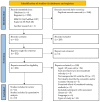The Effects of High-Speed Resistance Training on Health Outcomes in Independent Older Adults: A Systematic Review and Meta-Analysis
- PMID: 35564788
- PMCID: PMC9099943
- DOI: 10.3390/ijerph19095390
The Effects of High-Speed Resistance Training on Health Outcomes in Independent Older Adults: A Systematic Review and Meta-Analysis
Abstract
Human ageing involves several physiological impairments-in particular, a decrease in sensorimotor function and changes in the nervous system reduce muscle strength, power, balance, and functional capacity performance. Preventive strategies are essential to ensure the quality of life of the elderly. High-speed resistance training (HSRT) may be an effective approach to muscle power development in this population, with significant short-term effects on neural adaptations and muscle power production. Therefore, the present study intends to analyze and systematize the studies focused on HSRT interventions and their effects on health outcomes in independent older adults. Four electronic databases (PubMed, Web of Science, EBSCO, and Scielo) were used for the purposes of searching randomized controlled trials that measured at least one key outcome measure focusing on velocity-based training and health outcomes in older adults on 7 March 2022 and identified 1950 studies. At the end of the process, fourteen studies were included in this systematic review and ten studies were included in the quantitative analysis. The main results showed that HSRT interventions would improve health measures, mostly cognitive function (large effects, p = 0.001, SMD = 0.94), neuromuscular function (moderate effects, p = 0.003, SMD = 0.70), and physical function (moderate effects, p = 0.04, SMD = 0.55 and p = 0.009, SMD = -0.59). Additionally, the results suggested that interventions with ten weeks or more, performed three times a week, provide significant improvements in neuromuscular function. In this sense, HSRT is effective for improving overall health outcomes in older adults. Future studies should include proper follow-ups (e.g., minimum six months) to assess the durability of HSRT intervention effects on all health-related variables.
Keywords: health measures; high-speed resistance training; neuromuscular function; older people; power training.
Conflict of interest statement
The authors declare no conflict of interest.
Figures




Similar articles
-
Interventions for improving mobility after hip fracture surgery in adults.Cochrane Database Syst Rev. 2022 Sep 7;9(9):CD001704. doi: 10.1002/14651858.CD001704.pub5. Cochrane Database Syst Rev. 2022. PMID: 36070134 Free PMC article.
-
Music interventions for improving psychological and physical outcomes in people with cancer.Cochrane Database Syst Rev. 2021 Oct 12;10(10):CD006911. doi: 10.1002/14651858.CD006911.pub4. Cochrane Database Syst Rev. 2021. PMID: 34637527 Free PMC article.
-
Interventions for promoting habitual exercise in people living with and beyond cancer.Cochrane Database Syst Rev. 2018 Sep 19;9(9):CD010192. doi: 10.1002/14651858.CD010192.pub3. Cochrane Database Syst Rev. 2018. PMID: 30229557 Free PMC article.
-
Exercise interventions and patient beliefs for people with hip, knee or hip and knee osteoarthritis: a mixed methods review.Cochrane Database Syst Rev. 2018 Apr 17;4(4):CD010842. doi: 10.1002/14651858.CD010842.pub2. Cochrane Database Syst Rev. 2018. PMID: 29664187 Free PMC article.
-
Interventions for interpersonal communication about end of life care between health practitioners and affected people.Cochrane Database Syst Rev. 2022 Jul 8;7(7):CD013116. doi: 10.1002/14651858.CD013116.pub2. Cochrane Database Syst Rev. 2022. PMID: 35802350 Free PMC article.
Cited by
-
Monitoring Resistance Training in Real Time with Wearable Technology: Current Applications and Future Directions.Bioengineering (Basel). 2023 Sep 14;10(9):1085. doi: 10.3390/bioengineering10091085. Bioengineering (Basel). 2023. PMID: 37760187 Free PMC article. Review.
-
Mind body exercise improves cognitive function more than aerobic- and resistance exercise in healthy adults aged 55 years and older - an umbrella review.Eur Rev Aging Phys Act. 2023 Aug 9;20(1):15. doi: 10.1186/s11556-023-00325-4. Eur Rev Aging Phys Act. 2023. PMID: 37558977 Free PMC article. Review.
-
Characterization of Load Components in Resistance Training Programs for Kidney Transplant Recipients: A Scoping Review.Sports (Basel). 2025 May 19;13(5):153. doi: 10.3390/sports13050153. Sports (Basel). 2025. PMID: 40423289 Free PMC article. Review.
-
Effect of Physical Activity/Exercise on Oxidative Stress and Inflammation in Muscle and Vascular Aging.Int J Mol Sci. 2022 Aug 5;23(15):8713. doi: 10.3390/ijms23158713. Int J Mol Sci. 2022. PMID: 35955849 Free PMC article. Review.
-
Effects of High-Intensity Progressive Resistance Training Combined With Self-Talk on Muscle Strength and Functional Performance in Older Adults.J Strength Cond Res. 2025 Apr 2;39(7):736-744. doi: 10.1519/JSC.0000000000005115. J Strength Cond Res. 2025. PMID: 40194258 Free PMC article.
References
Publication types
MeSH terms
LinkOut - more resources
Full Text Sources

